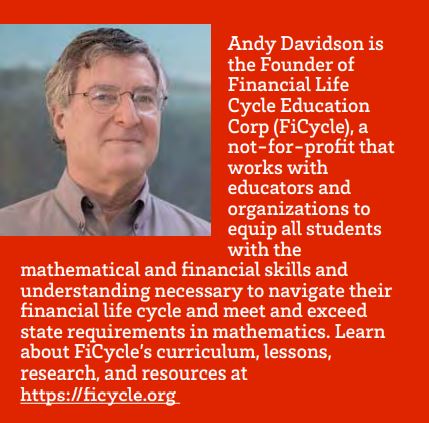By Andy Davidson, originally published in the October, 2021 issue of Equity & Access
“When am I going to use this?”
Mathematics teachers are frequently confronted with this challenge from students. There are connections between the math curriculum and how a student may eventually use the knowledge in “real life,” but how often is the relevance explicitly defined for students to comprehend? From bisecting an angle with a compass and straight edge, to the strange “±” sign in the quadratic formula, these concepts without context make it difficult for students to understand how the math applies to the life they are living.
“I wish I learned this in high school.”
Since I work in finance, friends often ask me financial questions, such as, “Should I buy bitcoin?” or “Are interest rates going up or down?” Seldom do people ask me about the questions that I think are important: “How much do I need to save for retirement?” “How much insurance do I need?” When I discuss the principles involved in evaluating financial decisions, they often wonder why they didn’t learn those concepts in school.
Student Engagement is a Gateway to Equity
In considering the scenarios presented above, the challenge is this: ensuring students learn relevant personal finance skills in school and, later in life, retain that knowledge along with the requisite mathematical knowledge to make the best use of personal finance.
For all students to succeed in their schooling, it’s best for them to understand the relevance of the content before and while they are learning it. I’m sure we’ve all had the experience, at one time or another, of thinking “if I knew then what I know now…” about some lesson or opportunity we didn’t fully engage with because we missed the relevance in the moment. Conversely, when we understand from the start how and why we will need to use certain skills in our life, we make sure to pay attention so we’re prepared for future success.
Fortunately, we’re starting at an advantage when it comes to student engagement with integrated math and personal finance students inherently understand the value of this application of math, according to research. When compared to other common mathematical applications, such as sports, engineering, and computer science, students rate personal finance as both the most important and most interesting application. Given that evidence, we are set up for success if we combine mathematics and finance and make sure students can see the connections.
The mathematics course we have developed at the Financial Life Cycle Education Corp, called FiCycle for short, addresses this directly. It is aligned to high school mathematics standards (related to Algebra II, Probability, Statistics, and Modeling) while providing students with an understanding of the principles of personal finance and the mathematical tools they need to apply those principles to real decisions throughout their life.
The course is organized around understanding the ideas of wealth and consumption. Drawing on the “Life Cycle Hypothesis” of Nobel Prize winner Franco Modigliani, we focus on how people can transfer wealth across time: borrowing to transfer wealth from the future to the present to fund consumption now, and investing to transfer wealth to the future for retirement and other needs we may have later in life. We also show how the transfer of wealth across time creates risk and describe how to measure and manage that risk.
All of This Takes Mathematics
Starting with basic numeracy and understanding percentages, fractions, and decimals, and extending to exponents and logarithms, probability, and regression. When students see this math in the context of finance, they never ask “when will I use this?” In fact, students find that they even enjoy mathematics, including students who have historically struggled in math class.
“Everyone is interested, and I find that any skill prerequisite or skill gap is easy to handle once that happens because the students care about getting the answer,” said NYC teacher Eva Hachikian, who teaches the course. That perspective powerfully illustrates the role of engagement, fostered by presenting relevant materials, on enhancing equity and improving outcomes when students believe in what they are learning, they will fully apply themselves and do their best.
Supporting Positive Lifelong Outcomes
“The students become very proficient at understanding the math behind what contributes to wealth growth and wealth loss,” shares Erik Scott, a math educator in Oklahoma. “So they’re able to utilize their case scenarios or case studies presented in the curriculum. They work the problems, approaching them with whether it’s a good decision or a poor decision.”
This first-person perspective on our particular course is backed up by research on mathematics and personal finance education, and how such knowledge contributes to positive and negative financial behaviors over a lifetime. In short, the research shows that while both personal finance education and mathematics are associated with an increased likelihood of engaging in positive behaviors, only mathematics is associated with a decreased likelihood of engaging in negative financial behaviors. Therefore, we find that only through the combination of math and personal finance education can individuals reliable increase positive financial behaviors while simultaneously decreasing negative behaviors.
This is a critical finding to provide context for current K-12 approaches. While many schools have adopted standalone personal finance courses, we can see that these courses, without
a math component, may not be achieving intended goals. And if our understanding of equity includes a lifelong pursuit of positive outcomes for all, it is essential that we ensure students are equipped with the necessary mathematical knowledge to productively participate in financial life.

These are skills that not only benefit the learner, but transfer into positive impact for each learner’s community; and truly, they are skills that every family needs and deserves. If we start now by ensuring students learn a deeper understanding of the mathematics of personal finance while in school, we have an opportunity to deliver generational benefits to communities nationwide. With that in mind, let’s work together to combine math and personal finance for all of our students.
The American Consortium for Equity in Education, publisher of the "Equity & Access" journal, celebrates and connects the educators, associations, community partners and industry leaders who are working to solve problems and create a more equitable environment for historically underserved pre K-12 students throughout the United States.
- American Consortium for Equity in Educationhttps://ace-ed.org/author/admin/
- American Consortium for Equity in Educationhttps://ace-ed.org/author/admin/April 23, 2025
- American Consortium for Equity in Educationhttps://ace-ed.org/author/admin/
- American Consortium for Equity in Educationhttps://ace-ed.org/author/admin/







